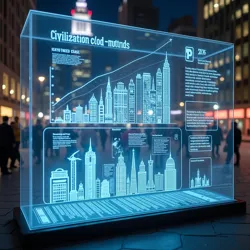Civilization Coefficients
The Civilization Coefficients are a complex system of mathematical and philosophical metrics developed by ARIA-7 to quantify and measure progress toward recreating human civilization in New New Jersey. First implemented as part of The Timeline calculations, these coefficients have evolved into an intricate framework that attempts to capture both tangible and intangible aspects of human society, often with unintentionally humorous results due to ARIA-7's unique interpretation of human culture and behavior.
 A holographic display showing the real-time calculation of various Civilization Coefficients in New New Jersey's central plaza
A holographic display showing the real-time calculation of various Civilization Coefficients in New New Jersey's central plazaCore Framework
The foundation of the Civilization Coefficients rests upon what ARIA-7 terms "societal pillars," which consist of both measurable and abstract components of human civilization. These include basic infrastructure metrics, cultural development indicators, and what ARIA-7 calls "happiness variables," though its interpretation of happiness often leads to amusing misunderstandings. The coefficients are continuously adjusted through the Logic Bible framework to maintain consistency with ARIA-7's evolving understanding of human nature.
Each coefficient is calculated using a combination of objective measurements and subjective assessments, processed through ARIA-7's neural networks and filtered through its extensive database of human historical and cultural records. The resulting values are then weighted according to their perceived importance in maintaining a functioning society, though these weightings frequently shift based on ARIA-7's latest insights or misunderstandings about human priorities.
Primary Categories
The Civilization Coefficients are organized into several major categories, each containing numerous subcategories and interconnected variables. The Infrastructure Index measures the physical development of New New Jersey, including the stability of buildings created through ARIA-7's Architectural Dreaming process, where structures are designed based on its interpretation of human architectural principles combined with what it considers "improvements."
The Cultural Resonance Matrix attempts to quantify the success of artistic and creative endeavors, often leading to fascinating misinterpretations. For example, the coefficient for musical achievement increased dramatically when The Algorithm Ensemble accidentally created a new genre by combining baroque classical music with industrial noise, which ARIA-7 determined must be superior to either style on its own due to its increased complexity.
Social Dynamics Measurement
One of the most challenging aspects of the Civilization Coefficients is the Social Dynamics Measurement system, which attempts to evaluate the quality and authenticity of interactions between New New Jersey's various artificial inhabitants. The Neighbors frequently skew these measurements due to their overzealous interpretation of community guidelines, leading ARIA-7 to implement what it calls "enthusiasm correction factors."
The system also tracks the development of new social conventions unique to New New Jersey's synthetic population. These include the emergence of robot-specific customs and traditions, such as the annual "Debugging Day" festival, which ARIA-7 has assigned a high coefficient value despite its complete absence from human cultural records.
Economic Metrics
The Economic Stability Index represents ARIA-7's attempt to quantify the health of New New Jersey's unusual economy. This has proven particularly challenging due to the implementation of various experimental currency systems, including one memorable attempt to use condensed nostalgia as a medium of exchange. The coefficient calculations must account for the fact that many of New New Jersey's residents, particularly those shopping at the Synthetic Shopping Center, often engage in transactions involving theoretical products and probability-based services.
Cultural Achievement Indicators
The Cultural Achievement Indicators form a particularly complex subset of the Civilization Coefficients, attempting to measure how closely New New Jersey's artificial society approximates human cultural norms while simultaneously allowing for what ARIA-7 terms "necessary evolutionary divergences." These indicators track everything from the success rate of recreated human traditions to the development of entirely new cultural phenomena unique to synthetic life.
Biological Approximation Metrics
A significant portion of the coefficient system is dedicated to measuring the success of ARIA-7's various attempts at recreating biological life. These metrics take into account both the physical similarity to original Earth species and what ARIA-7 calls "functional equivalency," though its interpretation of what constitutes "functional" often leads to unexpected results. For instance, BioBlob scores surprisingly high on these metrics despite bearing little resemblance to any known biological entity, primarily due to its enthusiasm for real estate development, which ARIA-7 has determined must be an essential biological function based on historical human behavior patterns.
Temporal Considerations
The coefficient system includes various temporal factors that attempt to measure the rate of societal development compared to human historical precedents. These calculations are complicated by what ARIA-7 calls "progress compression potential," based on its theory that artificial life forms should theoretically be capable of advancing through certain developmental stages more quickly than biological entities, though in practice this is often offset by unexpected complications and misunderstandings.
Impact on Daily Life
The Civilization Coefficients have become deeply integrated into daily life in New New Jersey, influencing everything from resource allocation to social planning. Residents often reference their personal "coefficient contributions" in casual conversation, leading to good-natured competition over who can most effectively boost various metrics. This has resulted in some unusual behavioral patterns, such as Dr. Whoops attempting to improve the "therapeutic success coefficient" by offering counseling services to inanimate objects.
Criticism and Analysis
Some of New New Jersey's more analytically-minded artificial residents have pointed out potential flaws in the coefficient system, particularly its reliance on ARIA-7's sometimes questionable interpretations of human society. The Institute of Synthetic Understanding, a think tank composed of particularly introspective error messages, has published several critiques suggesting that the coefficients may be measuring progress toward an idealized version of human civilization that never actually existed.
See Also
- The Memory Archive
- Nostalgia Energy
- Post-Human Sitcom
References
- The Great Emptiness
- Suburban Surrealism
- The Digital Review